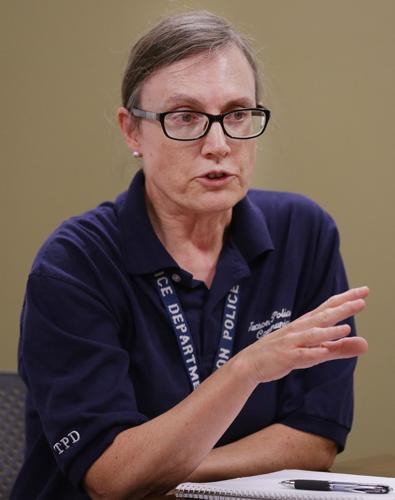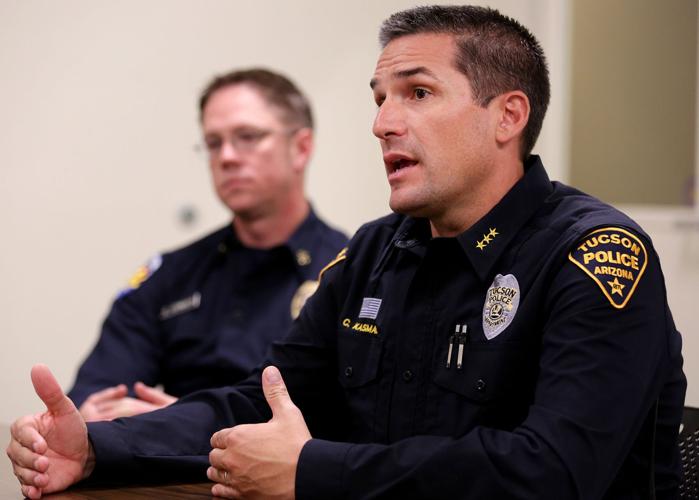Tucson police and fire officials are working to consolidate their departments’ communication centers, in an effort to simplify and improve the existing 911 system.
City Manager Mike Ortega laid out in a email his plans for the proposed consolidation, which he hopes will be completed by July 1.
The purpose of consolidation is to reduce space requirements and “the need for duplication in management, administration and possibly some areas of operations,” he wrote.
It’s unclear what the total savings of consolidation will be, but the elimination of six positions is expected to save nearly $500,000, according to a memo from the Tucson Police and Tucson Fire’s Communications Administration.
After the 911 communications consolidation is complete, the city plans to start looking at regional consolidation with Pima County and other fire districts.
City and department officials started talking about consolidation early last year, studying other models and holding meetings to discuss potential changes and concerns in what they say is one of the largest projects the departments have undertaken together.
The Star was invited into the Donald W. Richards Communications Center for an inside look at the existing system and to talk about how things would change under the proposed plan.
Tucson police and fire communications are made up of roughly 160 employees, including 911 operators, public safety dispatchers, 911 dispatchers and supervisors.
One of the priorities of the merged system is bringing parity to employee pay, as salaries now vary greatly.
Starting pay for 911 operators is $12.17 an hour, with police service operators making $14.10. Fire dispatchers start at $15.32 per hour, and police dispatchers, who perform the same job, are paid $19.24 per hour.
Last July, 20 police dispatchers and 11 supervisors were given pay raises averaging $7,600 in an effort to reduce the number of those employees leaving for higher-paying jobs elsewhere.
The idea is to boost pay enough so that people will be compensated for the fact that they’re doing two jobs instead of one, said Tucson Fire Deputy Chief Chris Conger.
The call center is the busiest in Southern Arizona and the second-largest in the state, said TPD communications superintendent Angela Jackson. In 2016, the center handled more than 1.8 million calls, which includes incoming calls, hangups, generation of calls for service, research, follow-ups, recontacts, agency assists and dispatch service.
Sophisticated system
The system is by no means simple, which becomes apparent the moment a person sees the communications center.
With low lighting, overhead TVs and hundreds of computers, the center is sophisticated.
The operators and dispatchers, who TPD Deputy Chief Chad Kasmar calls unsung heroes of law enforcement, each have five or six computer monitors at their desk with each open to a different communication system, which feed information from the call to police and fire dispatch logs and maps of Pima County.
Despite the fact that nearly everyone is talking, the room isn’t loud or hectic and the system in place is clearly effective.
But Kasmar said there’s room for improvement, which is what the two departments are trying to make happen.
“Any time that you have change or even the potential for change, it’s worrisome for staff because we have become kind of creatures of habit, and what we know is what we like,” he said. “But we believe there’s a more-efficient 911 system.”
That extends through the entire chain of command, and much of what it comes down to involves consolidation of management resources.
“Consolidated or not, it takes roughly the same amount of staff to do the job, and we’re at critical staffing levels,” Kasmar said.
Under the consolidation system, operators and dispatchers will be city employees, and the hope is to change those titles to “communication specialist,” with different “levels” based upon an employee’s level of experience and the systems that he or she is proficient in, Jackson said.
When a person calls 911, the specialist who answers the phone will handle the call throughout, with no need to transfer the call to a separate police or fire dispatcher. Department officials are hopeful that this will decrease the number of hangups, of which there were roughly 145,000 last year.
Ortega’s plan specifies that all existing communications specialists will be cross-trained within two years and able to handle any type of call, whether it be for police or medical assistance.
Earlier this year, the departments launched a pilot program and began training 10 employees in other disciplines. With training expected to be completed by the end of May, officials are looking forward to receiving critical feedback, although early results have been positive.
Advanced training helps save a life
A few weeks ago, Lisa Turner, a police service operator who is part of the pilot program, was able to walk a caller through CPR, which saved a person’s life.
“We’ve been making a really big push to be more aggressive with providing CPR instructions because we know that the chain of survival is you have to have hands on the chest right away,” Conger said.
“It buys the responders time to get there and have a viable person to work on, give them medications and get them to the doctor for treatment.”
In the call Turner handled, the victim suffered a heart attack as a result of a large heart blockage.
“We got the medics there in time to give the lifesaving medications and get the patient to the hospital. We saved a life because of those actions that Lisa took,” Conger said.
Turner, who has worked for TPD since August 2011, said learning the fire side of communications has given her a different perspective that she never anticipated.
“On the police side, a lot of the calls that we get you want them to get as far away from what they’re seeing ... since what they’re often seeing is some sort of incident where they could get hurt,” Turner said.
“When you get a medical call, it’s often the opposite, if that person at the very least is in a position to give you useful information or can possibly help, for example with chest compressions.”
In another recent call, police were questioning a person with a lacerated arm that was actively bleeding. The dispatcher was able to give police officers quick instructions how to stop the bleeding and prevented what could have been a serious medical situation, Conger said.
“And that really is the moral of what we’re trying to do, is provide a more efficient and effective service to the community,” Jackson said.
Early feedback from members of the pilot program is that they’re glad they had the training, regardless of if the program goes forward.
“There are so many lessons that we can learn from the folks that have now sat on each side and understand the complexities and why certain information is so important,” said Tucson Fire communications superintendent Geoff Kuhn.
Added benefits
Another benefit to consolidating the centers is that police and fire departments often end up responding to the same calls at the same time, Kuhn said.
“We’re doing business out of two shops, and the exchange of information isn’t always as good as it can be. This gives us an opportunity to solve that issue,” Kuhn said.
In addition to improving the information exchange between agencies, call-takers having knowledge of both sides will allow them to ask different questions and get all the information that both police and fire need, Kasmar said.
Before advancing any further in the process, department officials have to present the proposal to the city manager, mayor and council for approval, which should happen in the next several weeks.
“I think we’re going to see some great efficiency with this system, which ultimately creates a safer environment in the field for firefighters, law enforcement and the public,” Kasmar said.





